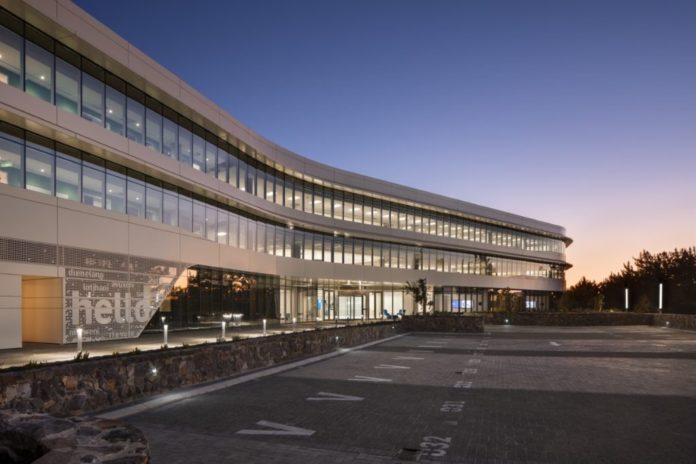IKhaya means ‘home’ in Xhosa and Capitec Bank have built its new ‘home’ headquarters in Stellenbosch, Western Cape, South Africa. The bank is known as one of the largest and most progressive banks in Africa. Designed by multidisciplinary studio, dhk Architects, the three-storey curvilinear building is defined by its , which embodies the company’s progressive outlook and embraces the concept of agile working. Striking and otherworldly, dhk’s holistic architectural approach considers both the exterior and interior to optimise corporate expenditure, internal flow and sustainability – demonstrating that commercial offices can be innovative and cost-effective while driving operational efficiencies.
Capitec’s success and growth over time meant that the company came to occupy numerous offices. These offices were geographically dispersed, resulting in departments becoming increasingly isolated from one another with the need to move between buildings to meet face-to-face. Consequently, Capitec opted to consolidate its staff and facilities into one operationally efficient headquarters. Located in the scenic Cape Winelands in South Africa, a key driver of the design concept involved capturing panoramic vistas and drawing the landscape within.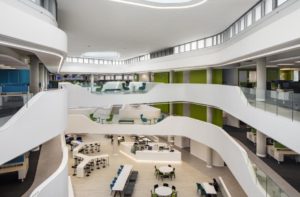
The building form optimises the shape and size of the site while referencing the brand’s distinctive curved logo. The three-storey superstructure wraps around itself, which creates a unique ‘doughnut’ shape and forms a central triple-volume atrium – an internal ‘social spine’ at the heart of the building. Contributing to the contemporary appearance, white aluminium panels clad the building’s sinuous form which is further accentuated with continuous ribbons of fenestration.
Interior design
Internally, the interior design resonates with the company’s progressive outlook – ensuring guests and staff unequivocally feels the spirit of the brand throughout the building. Once at reception, visitors are greeted by a generous triple-volume space that immediately showcases the sophistication and simplicity of the interior architecture. Wide open-plan floorplates loop around the periphery of the atrium which are connected by a series of dramatic bridges and staircases. This was an intentional design element which inter-connects the various departments, creating opportunities for chance collaborative encounters and personal interactions.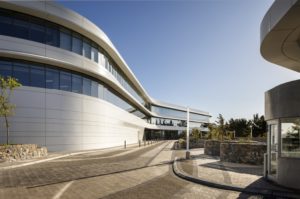
The design concept for the building’s interior was based on the value of simplicity and brand colours which were only used in the reception and external meeting rooms, to reflect their values. Each core or ‘hub’ within the building was given an identity by assigning a colour to both the core and the surrounding furniture, in order for staff to orientate themselves while moving throughout the building. Signage plays an integral part in the interior design with brand signs appearing in the morning and disappearing in the evening when the signage lighting is switched on/off, leaving a smooth polished white finish. Artworks in the form of large format acoustic panels were used in the meeting rooms and furniture was upholstered in vibrant colours to offset the white modern interior.
Lighting design
Reinforcing Capitec’s brand identity, the company logo is embossed into the ceiling above reception. Overhead, clerestory windows and large roof lights ensure plentiful natural light and further facilitate the connection to the outside world. Meanwhile, touches of timber have been added throughout the office to introduce a feeling of warmth. Natural light is optimised via clerestory glazing, roof lights and internal courtyard windows, while artificial lighting is zoned and activated by sensors.
A 1,4 km versatile linear system from Province Lighting was used to provide the perfect combination of light and architectural enhancement to the building. The company developed a custom lighting solution to flow with dhk Architect’s curved building design and sufficiently illuminate the space. Sirius down lights were also added to general circulation areas of the building.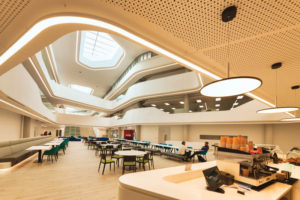
“The first requirement in terms of lighting was to meet the SANS requirements, and secondly to be efficient. The curvilinear geometry of the interiors did present a challenge, however. We wanted to ‘scribe’ the shape of the atrium form in accent lighting and traditional details and LEDs proved unsatisfactory,” explains Peter Stokes, partner at dhk and lead architect on the iKhaya project. “A new lighting product became available during the course of the building’s design that allowed us to simplify the bulkhead/cove detail and simplify construction,” he adds.
Stokes notes that the lighting is purposefully restrained. External lighting to highlight the building was discouraged by the client, and due to the sensitivity and prominence of the site, minimising light pollution for neighboring developments was a key consideration. “Therefore, minimal artificial lighting to accent the building was allowed and natural light was optimised to illuminate the atrium space.” Elsewhere, lighting solutions were specific to particular activity areas, including open plan resident desk areas, meeting rooms, collaboration spaces, pause areas, kitchenettes, and back-of-house areas.
Steel solution – Complexity in design
In January 2019 Macsteel partnered with AECOM & LRJ steel for the design and development of Capitec Bank’s new head office and adjoining parking structure. Succeeding the consultation with the architect, the understanding was to design and build a contemporary, open office that allowed a fluid and collaborative work environment. From the start of the project, the team used Building Information Models (BIM), which represented the actual construction, allowing all partners involved to fully understand the configuration of the planned structure, ensuring a collaborative vision of how the various components interacted.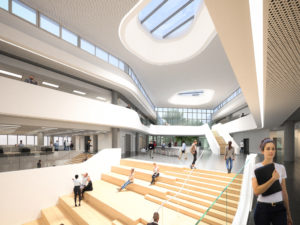
The design solution was predominantly a concrete framed structure, however, structural and composite steel and concrete construction were used in a complimentary way. Additionally, bridge links and the floor over the mail entrance required light, long span structures with limited headroom implications. The parking structure required the use of a solution that would be removable in the long term conversion of the building for a different use.
Optimising internal flow
The new headquarters by dhk fosters a company culture of creativity, innovation and collaboration with a large emphasis placed on optimising internal flow and departmental interaction. The first and second floors, containing the office’s open-plan work areas, are largely void of hierarchal structure and closed-off cubicles. Embracing the concept of agile working, a raised access floor throughout the building facilitates maintenance and future upgrades to services. On each level, a total of four ‘cores’, containing centralized amenities such as kitchenettes, meeting rooms, breakout areas, lockers, bathrooms and fire escapes, serve to augment the floorplates into departmental zones.
Throughout the building’s ‘social spine’ there are a variety of breakaway areas; from a large ground-floor lounge at reception for guests to await meetings and co-workers to engage, to pause areas on bridges, and an internal landscaped courtyard for staff to rest. These spaces fuel creativity and innovation by allowing employees to slip away from their resident desks to enjoy a moment of solitude, conduct a private meeting or brainstorm ideas in small groups.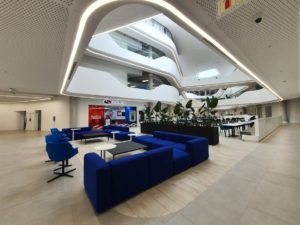
Not only do these breakout areas increase job satisfaction, but they boost staff productivity and efficiency. Furthermore, there is a full-service kitchen and canteen area with ample seating, a small satellite café, and a grand multifunctional stadium staircase/seating area for company presentations and talks. Other useful facilities include a recording studio, Capitec Bank branch and an ATM lab facility.
Comfort solution
Capitec has championed environmental sustainability and employee well-being throughout the building particularly where it made sense and value could be demonstrated. Even the air conditioning system is based on these values. To enhance the energy efficiency of the building while maintaining internal comfort all year round.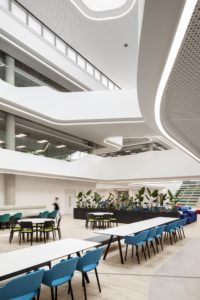
Since a large part of the building features large open-plan spaces for the training rooms and offices, these areas were fed with air-handling units located at the roof plant. A requirement was that the meeting rooms should be noise sensitive.
In general, the building has been zoned by similar usage spaces, Internal seating zones as well as external perimeter zones. The benefit of the zoning feature is that the building can be either heated or cooled simultaneously.
Bonding Solution
Glazing of the glass on the Capitec building was one of the final finishes required, and that task went to Sika. The glass is a beautiful feature that enhances the entire look of the building so a range of Sika products were used to ensure stability and security of the glass. Sikasil® IG-25 Structural Secondary Seal was used in manufacturing the double-glazed insulated glass. Sikasil® SG -500, a 2-part structural silicone, bonded the insulated glass units to the façade frame. Sikahyflex- 305 AP Weather Sealant and the surface preparation primer, Activator- 205 Cleaner for Aluminium, were both used to weather seal the bonded insulated glass units on the facade. A total of 3,850m2 of glass was used on this building project and the value of the products used on the glazing of the glass is estimated at R1.58 million.
Major challenges of this project were to meet daily insulation and manufacturing targets, whilst managing the transportation and handling of panels. Despite the difficulties, one of Sika’s reliable technical consultants, Chris Sharpe, ensured that damaged panels were replaced and new installations effected smoothly. No doubt the technical training and support afforded the contractors by Sika, contributed greatly to the success of the project.
“The Capitec Headquarters is one of the most architecturally beautiful corporate buildings in the country. The ability to accommodate all the business branches in one building enables an effective and efficient working unit. Looking at the result, most would agree it was definitely a necessary and worthwhile project. Bank on it!,” says Sika.
Sustainable measures
Environmental performance modelling directly influenced the articulation of the façade. The design applied a climate- and site-responsive approach to the fenestration layout. Excess heat from the sun was reduced by varying the simple ribbon of fenestration in response to the ever-changing orientation of different parts of the building. The process informed areas of fenestration, glazing specification, glare control measures and solar shading. Performance modeling also informed the primary ordering of the internal layouts. For example, a circulation zone was provided along the external perimeter of the building to distance resident desks from sources of radiant heat.
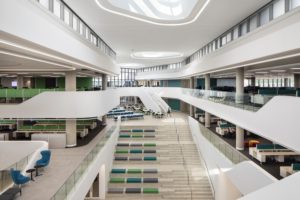 The thermal mass of the concrete building superstructure is exposed in various areas and the basement is naturally ventilated. Other sustainability measures include ice storage to offset peak electrical demands, a greywater system, water-saving fittings, building management system for extensive metering and monitoring, double glazing throughout, use of good quality and low maintenance materials, locally sourced materials, water-efficient heat rejection, zero ODP (Ozone Depletion Potential) refrigerants, use of low VOC (Volatile Organic Compounds) finishes, borehole and rainwater harvesting for irrigation, water-wise planting and refuse management to encourage separation of waste and recyclables.
The thermal mass of the concrete building superstructure is exposed in various areas and the basement is naturally ventilated. Other sustainability measures include ice storage to offset peak electrical demands, a greywater system, water-saving fittings, building management system for extensive metering and monitoring, double glazing throughout, use of good quality and low maintenance materials, locally sourced materials, water-efficient heat rejection, zero ODP (Ozone Depletion Potential) refrigerants, use of low VOC (Volatile Organic Compounds) finishes, borehole and rainwater harvesting for irrigation, water-wise planting and refuse management to encourage separation of waste and recyclables.
To promote employee well-being, the building is purposefully limited to only two passenger lifts for its workforce of approximately 2,000. This is supplemented by a variety of generous feature stairs to encourage walking and limit the use of confined lift spaces. As such, the fire escape stairs were designed for dual functionality; where the quality of finishes were upgraded, they serve as ‘communication’ stairs.
Further promoting employee well-being and to ensure that the needs of universal access were met, Capitec engaged with a disability consultant and an acoustic specialist early on in the design process. The recommendations of both specialists were incorporated into the building. For example, sound-absorbing materials and acoustic separation between meeting rooms were included throughout the building to achieve a specified performance in terms of decibel reduction.
Additionally, and beyond the requirements of the regulations, consideration of car parking locations, emergency evacuation, ablutions and vertical circulation, are all examples of how the spirit of universal and inclusive access have been addressed.
Capitec rehabilitated a neighbouring area of public open space to be used by staff and the broader community as a recreational area for activities such as walking and running. Fittingly, the building also provides cyclist facilities and purpose-designed showers.
Looking to the future, the development incorporates a car parking structure on an adjacent site that follows iKhaya’s core principles, designed for future adaptation into an office should there be a modal shift towards public transportation and less reliance on private cars.
Peter Stokes, a partner at dhk and lead architect on the iKhaya project says, “Capitec is a renowned South African brand that highlights values of simplicity, innovativeness and collaboration. dhk sought to create an extraordinary, world-class office that is progressive and relevant in the South African context – designed to be agile, drive productivity, increase operational efficiencies and ultimately reduce company operational expenditure”


